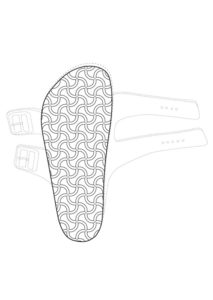The UK Intellectual Property Office has recently declared invalid Birkenstock’s UK trade mark registration for the pattern on the sole of their shoes. The decision of the Appointed Person, James Mellor QC, not only considers a slightly unusual mark, it also provides helpful guidance on factors to consider if a brand owner is trying to show acquired distinctiveness of its sub-brand.
The original decision
The dispute arose following Eurogloria s.l.’s application for a declaration of invalidity against Birkenstock’s UK trade mark registration for a ‘pattern applied to the sole of footwear’. Birkenstock’s mark was registered in respect of orthopaedic footwear in class 10 and footwear generally in class 25.
The action was based on Sections 3 (1)(b), (1)(c), (1)(d) and (2) of the UK Trade Marks Act 1994, with the applicant alleging that the mark was devoid of distinctive character, descriptive of the goods, customary in the trade, and that it fell foul of all of the shape objections. Interestingly, it only succeeded in relation to Section 3 (1)(b) for a lack of distinctiveness, with Birkenstock unsuccessfully arguing that the mark had acquired distinctiveness through use.
The Appeal
Birkenstock appealed the Hearing Officer’s original decision to Appointed Person, and sought to do so under three main headings of appeal.
These were:
- The Hearing officer committed seven errors in coming to her decision, the first six of which would render original decision unsound if found to be correct;
- If no individual error is substantial enough, the Hearing Officer came to a decision which no other reasonable Hearing Officer would have come to, based on the evidence; and/or
- The Hearing Officer committed five errors in failing to find the Birkenstock sign had acquired distinctiveness.
The Appointed Person went through each of these grounds of appeal, and ultimately found none of them to have any significant weight. As a result, the original decision was upheld, with Birkenstock’s registration being declared invalid for a lack of distinctiveness.
They also failed to meet the bar for acquired distinctiveness through use and this is perhaps the most interesting part of the case, namely the discussion around acquired distinctiveness of a sub-brand when used alongside or in conjunction with a main brand.
Acquired distinctiveness
Birkenstock argued that their sole device was a sub-brand, under their main BIRKENSTOCK brand. They further argued that, based on the Hearing Officer’s original decision, ‘no sub-brand could ever have acquired distinctiveness when sold in conjunction with a main brand’.
Birkenstock were nothing if not resourceful in providing evidence to demonstrate that the mark had acquired distinctiveness. In addition to the usual sales figures and samples of advertising, their evidence included extracts from a blog which discussed the incorrectly aligned pattern on the sole of a pair of counterfeit Birkenstock sandals. This, it was argued, demonstrated that counterfeiters saw the pattern on the sole as necessary to indicate the origin of the goods. At least one part of the relevant public had therefore come to understand the pattern as a brand. However, the Appointed Person took the view that this evidence only demonstrated that counterfeiters try to reproduce the genuine goods, and was not evidence that the sole pattern is regarded as a badge of origin, either by counterfeiters or the general public.
The Appointed Person noted that it’s ‘a common and well-recognised problem’ that it is hard to show that one part of the appearance of the goods conveys an origin message, when the ‘main brand’ itself normally conveys a very clear origin message of its own.
However, he stated that one potential option, and way to show that a sub-brand conveys the necessary origin message, is by showing that the brand owner has ‘the confidence to rely on the sub-brand to convey an origin message in its marketing’.
It therefore seems that there are two questions which need to be answered when trying to show that a sub-brand has acquired distinctiveness:
- Whether the brand owner trusts the sub-brand to convey the necessary origin message; and
- Whether that trust, and the origin message, are clear in the brand owner’s marketing
Whilst it therefore appears possible to envisage circumstances where a sub-brand is used alongside or in conjunction with the main brand, and can meet these theoretical two requirements for acquired distinctiveness, it would appear to be significantly harder than using the sub-brand alone – which would show a far higher level of trust in the sub-brand and its ability to convey the origin message.
Whilst this guidance from the Appointed Person may suggest that it’s getting harder to prove acquired distinctiveness of a sub-brand, it does at least provide a useful steer on the sort of use which brand owners should be making of their trade marks if they want to obtain UK trade mark protection through acquired distinctiveness.
_____________________________
To make sure you do not miss out on regular updates from the Kluwer Trademark Blog, please subscribe here.



